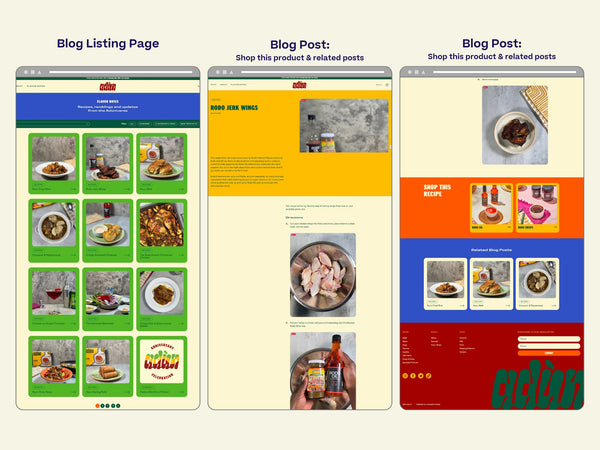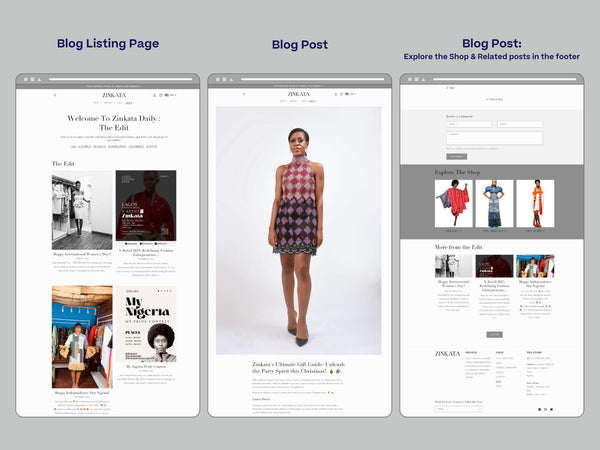Drive traffic and engagement with blogging on your e-commerce store
Blogging is a great way to get potential and repeat customers to come to your website, stay on your website, and ultimately buy from you. Here's the ultimate guide to blogging in Shopify.
Why you need a blog for your e-commerce store
There are so many great reasons to have a blog on your e-commerce store. Here are some:
Blogging is great for SEO (Search Engine Optimization).
The caveat is that you need to blog with intention. Doing keyword research helps. However, lots of my blog posts were written to answer questions from customers. If you have an idea, I say go with it, and you can refine after SEO keyword research is done.
Blogging helps you educate your leads and customers.
Customers have so many questions. Yes, you may have an FAQ section, but a blog can share more details and give more behind the scenes information about your brand. There is so much you can share with a blog on your e-commerce store:
- Inspiration behind a new collection
- Behind the scenes of your latest product design
- Tips on using your products
- Your company story
- Customer spotlight series
- Recipes, style guides, and seasonal tips
Blogging increases dwell time on your website.
The longer a customer is on your website, going through your blog and getting to know your company and products more, the more likely they are to subscribe to your emails, and buy from you.
Blogging can help you create content for social media.
You can get 5-10 pieces of content for your social media posts from one blog post alone. This can save you time and help you have themes for your content. For example, I could choose a theme for each week, write a blog post to support the theme, and then make social media posts from the blog content.
That being said, some e-commerce stores choose not to have a blog. Here are some reasons:
Why you might not want to Blog in Shopify
Blogging is time consuming.
It takes time to create quality blog posts that educate and inspire customers. It takes time to plan the blog post, edit the copy, photos, do the SEO research, and publish the blog posts. Also, blogging might take time to bring you traffic.
Tips For Blogging In Shopify
It's easy to blog in Shopify. When you log in to your Shopify backend, simply go to Online store > Blog posts, and create your first blog. Some tips for blogging in Shopify:
- New blog posts are hidden by default, so you can create drafts and go on to edit them later. You can also set a time for the blog post to be published.
- Tag your blog posts to help you organize them, and also help the reader to click the tags to jump to similar topics.
- You can update your blog on many devices - your desktop, tablet or on your phone using Shopify IOS app or Google app.
- Shopify has a default template for your blog and blog post, but did you know that you can create different templates? You can have more than one blog on your Shopify store, and have templates for each. For example, you might decide to have a Press blog, and a Recipes blog, with different templates to support each.
- Show read time on each blog post to help busy users
- Use headings and sections to make your blog post scannable.
- Don't forget SEO sections when editing your blog - Add an ALT description to all your images, and add your SEO title and summary.
-
Use a Canva template to ensure that all your blog images have the same dimensions and a similar design. You may want to have two templates - one for inline images in your blog, and another for the featured image
Blogging in Shopify vs WordPress vs Squarespace vs Showit
How does Shopify compare with other e-commerce platforms for blogging? here are the deets.
WordPress
WordPress is the king of blogging. It was built primarily for blogging and I still miss it. The layout, the management of categories, and ease of creating blog posts is unmatched. I also love that you can schedule blog posts from some social media tools like CoSchedule.
Score: 5/5
Squarespace
Squarespace's blogging capability is pretty great. It is not as robust as WordPress, but blog posts are easier to create and edit than Shopify. A caveat - Squarespace does not have a template you can use across blog posts like Shopify. I also prefer Shopify's blog management interface, for searching, organizing and filtering blog posts.
Score: 4/5
Showit
Showit is such a beautiful and flexible website creation platform, however, it needs WordPress for blogging. Here's how it works. After creating your Showit account, you need to request for the Showit team to create a WordPress account with separate login. It's messy, y'all. Yes, it's nice to have the capability of WordPress and Showit combined, but, you STILL need to connect to an e-commerce tool like Shopify. That means, for an e-commerce store, you need three platforms just for your website. I am all for keeping things simple, and that is why I prefer Shopify to Showit.
Score: 3/5
Choosing a Theme for Blogging in Shopify
If blogging is a key strategy to bring in traffic on your e-commerce store, then it's important to pick a theme that perfectly showcases your blog. Before your select a theme, check the theme's demo to see how the blog looks. What are some things to check in a Shopify theme for your blog:
- The Blog Section: How does the blog section look? Does it allow you to change the blog post image formats, number of blog posts per line, date, author, excerpt, and grid design? The more settings you can tweak, the better to design your blog.
- The Blog Post: Are you able to add a sidebar to your blog posts? What can you add in the Sidebar? Is there a breadcrumb? Can you add tags and change the image layout? Can you change the "Other Blog Posts Your May Like" section?.
Some Great Examples of Blogs in Shopify
Getadun.com

The Contract Shop

Never alone candles

Zinkata
Getting Conversions From Your Blog
You have a goal for setting up your blog and I believe you want your investment in your blog to pay off. Here are some tips to get you closer to reaching your blog goals:
Sell more products on your blog
Here are places to link to your products in your blog posts:
- Add an image to represent the collection halfway through your blog post.
- Add "shop this product" at the end of your blog post.
- Add links to the text within your blog posts.
Get more email subscribers from your blog
Here are places to place your lead magnet on your blog:
- Within your blog posts (as an embedded form)
- On your blog side bar
- At the footer
- As a link within the blog post E-commerce Monthly Management service
While blogging can be time consuming, it can be worth the investment to bring more traffic and sales to your e-commerce store.
Need help with blogging for your e-commerce store? Here's how we can help:
- Need an E-commerce growth partner to take charge of blogging for your e-commerce store? Our is for you.
- Need help to set up your blog design and create a few blog posts, with training to help you take charge after that? Our Shopify VIP Day would be the service for you.





